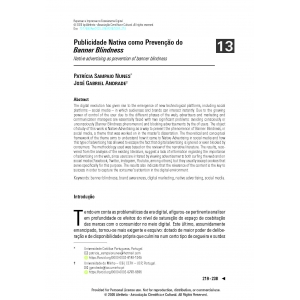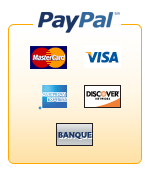Benway, J. & Lane, D. (1998). Banner blindness: Web searchers often miss “obvious” links. Internetworking, 1, 3.
Benway, J. P. (1999). Banner blindness: What searching users notice and do not notice on the World Wide Web. Ph. D. Dissertation, Rice University.
Campbell, C. & Marks, L. (2015). Good native advertising isn’t a secret. Business Horizons, 58 (6), 599-606.
Cardoso, G. (coord.) (2013). A sociedade dos ecrãs. Lisboa: Ed. Tinta da China.
Carrera, F. (2014). Marketing digital na versão 2.0 – O que não pode ignorar. Lisboa: Edições Sílabo.
Cordeiro, A., Oliveira, G., Rentería, J. & Guimarães, C. (2007). Revisão sistemática: uma revisão narrativa. Revista do Colégio Brasileiro de Cirurgiões, 34 (6), 428-431.
Edwards, S., Li, H. & Lee, J. (2002). Forced exposure and psychological reactance: Antecedents and consequences of the perceived intrusiveness of pop-up ads. Journal of Advertising, 31 (3), 83-95.
Estrada-Jiménez, J. et al. (2017). Online advertising: Analysis of privacy threats and protection approaches. Computer Communications, 1-20.
Evans, D. (2009). The online advertising industry: economics, evolution, and privacy. The Journal of Economic Perspectives, 23 (3), 37-60.
Jenkins, H. (2009). Convergence culture: Where old and new media collide. Nova Iorque: New York University Press.
Katz, H. (2016). The Media Handbook: A complete guide to advertising media selection, planning, research and buying, N-Y: Routledge. Versão Ebook [on-line].
Kerpen, D. (2011). Likeable Social Media: How to delight your customers, create an irresistible brand, and be generally amazing on Facebook (& Other Social Networks), Nova Iorque: McGraw-Hill [on-line].
Kim, B., Pasadeos, Y. & Barban, A. (2001). On the deceptive effectiveness of labeled and unlabeled advertorial formats. Mass Communication and Society, 4 (3), 265-281.
Kotler, P., Kartajaya, H. & Settiwan, I. (2017). Marketing 4.0: Mudança do tradicional para o digital, Lisboa: Actual Editora.
Lee, C. (2015). Banner blindness: An effect of information overload on the World Wide Web. [on-line] Disponível em <http://www.carrielee.net>. Consultado a 12/10/2017.
Loranger, H. (2013). Fight Against “Right-Rail Blindness”. [on-line] Disponível em https://www.nngroup.com/articles/fight-right-rail-blindness/. Consultado a 12/03/2018.
Mack, A., & Rock, I. (1998). Inattentional blindness. Cambridge, MA: MIT Press.
Nielsen, J. (1997). How users read on the web. [on-line] Disponível em <http://useit.com/alertbox/9710a.html> Consultado a 12/06/2018.
Nielsen, J. (2007). Banner Blindness: Old and new findings. [on-line] Disponível em <https://www.nngroup.com/articles/banner-blindness-old-and-new-findings/> Consultado a 14/05/2018.
Nielsen, J. (2015). Trust in Advertising. [on-line] Disponível em <http://www.nielsen.com/pt/pt/press-room/2015/A-publicidade-mais-confiavel-paranove-em-cada-dez-portugueses-e-a-recomendasao-de-familiares-e-amigos.html> Consultado a 5/08/2017.
Pernice, K. (2018). Banner Blindness revisited: Users dodge ads on mobile and desktop. [on-line] Disponível em <https://www.nngroup.com/articles/banner-blindness-old-and-new-findings/>. Consultado a 11/07/2018.
Qualman, E. (2010). Socialnomics:Como os media sociais estão a tranformar o modo como vivemos e como fazemos negócios. Lisboa: Editorial Presença.
Resnick, M. & Albert, W. (2014). The Impact of Advertising Location and User Task on the Emergence of Banner Ad Blindness: An Eye-Tracking Study. Intl. Journal of Human-Computer Interaction, 30, 206-219.
Shimp, T. (2010). Integrated marketing communication in advertising and promotion. 8th edition, South-Western: Cengage Learning.
Yoo, C. Y., Kim, K. & Stout, P. (2004). Assessing the effects of animation in online banner advertising: hierarchy of effects model. Journal of Internet Advertising, 4, 2, 49-60.
Yuan, S., Abidin, A., Sloan, M. & Wang, J. (2012). Internet advertising: An interplay among advertisers, online publishers, ad exchanges and web users. ArXiv: 1206.1754, arXiv preprint.
Yuan, S., Wang, J., Zhao, X. (2013). Real-time bidding for online advertising: measurement and analysis. Proceedings of the Seventh International Workshop on Data Mining for Online Advertising, AMC, 3.









